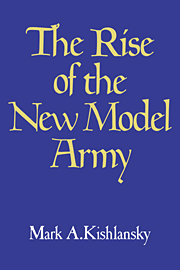6 - The Reign of Parties
Published online by Cambridge University Press: 17 September 2009
Summary
The Presbyterians now carry all things with a high hand.
By the close of 1646 the transformation of the political process was completed. For four years the ties that bound together the diverse supporters of the parliamentary cause had remained tangled and knotted. Throughout the war conflicting partisan alternatives had been either encompassed or circumvented as Parliament refused to choose between war and peace in 1643-4 or to decide the establishment of the church in 1645. Whether, in the absence of the monarch, parliamentarians consciously refrained from innovations that might impede a settlement, or, in the confusion of rebellion, they were simply incapable of policy making, parliamentary unity had endured. Through the tensions heightened by the creation of the New Model Army, through the establishment of permanent poiltical factions, and through the machinations of the Scots and the City, political power had remained diffused.
Yet the political practice that had been so well suited to waging war quickly became an obstacle in settling peace. During the fighting political indecision had been relieved by the appointment of executive committees and military councils, but once the war had ended Parliament again assumed the burden of decision making. Almost immediately the political process convulsed. Pressure groups emerged from among those who had provided the cause with its money and manpower. Their claims to a voice in guiding the nation to peace were accepted by leaders of the parliamentary factions who had vied for the adoption of their own visions of the future.
- Type
- Chapter
- Information
- The Rise of the New Model Army , pp. 139 - 178Publisher: Cambridge University PressPrint publication year: 1980



